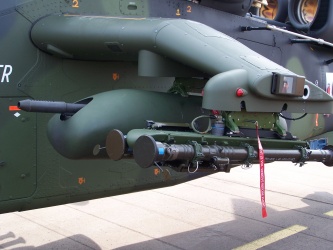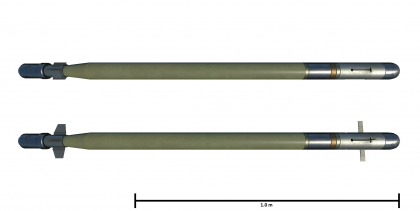Difference between revisions of "ATAS (AIM-92)"
Colok76286 (talk | contribs) (→History: Added main article) |
Colok76286 (talk | contribs) (→References: Edits) |
||
| Line 114: | Line 114: | ||
;Bibliography | ;Bibliography | ||
| − | |||
* GlobalSecurity.org "Chapter 3: Firing the Stinger" ''Global Security'', [https://www.globalsecurity.org/military/library/policy/army/fm/44-18-1/Ch3.htm Website]. Accessed 07 Apr. 2021 ([https://web.archive.org/web/20210407192257/https://www.globalsecurity.org/military/library/policy/army/fm/44-18-1/Ch3.htm Web Archive]). | * GlobalSecurity.org "Chapter 3: Firing the Stinger" ''Global Security'', [https://www.globalsecurity.org/military/library/policy/army/fm/44-18-1/Ch3.htm Website]. Accessed 07 Apr. 2021 ([https://web.archive.org/web/20210407192257/https://www.globalsecurity.org/military/library/policy/army/fm/44-18-1/Ch3.htm Web Archive]). | ||
* Lawrence, John S, et al. ''Preliminary Airworthiness Evaluation of the AH-64A Equipped with the Air To Air Stinger (ATAS) Missile System''. Defense Technical Information Center, December 1988. | * Lawrence, John S, et al. ''Preliminary Airworthiness Evaluation of the AH-64A Equipped with the Air To Air Stinger (ATAS) Missile System''. Defense Technical Information Center, December 1988. | ||
Revision as of 07:35, 22 September 2022
Contents
Description
The AIM-92 Air-to-Air Stinger is an American infrared homing air-to-air missile. It was introduced in Update 1.91 "Night Vision". It is a helicopter-mounted variant of the well known FIM-92 Stinger fire-and-forget shoulder-fired anti-air missile.
Vehicles equipped with this weapon
- A129CBT
- AH-64A
- ▃AH-64A Peten
- AH-64A
- AH-64A Peten
- AH-64D (Modification)
- AH-64DJP (Modification)
- Saraph
- AHS
- EC-665 Tiger UHT
- G-LYNX
- Lynx AH.Mk.1
General info
| Missile characteristics | |
|---|---|
| Mass | 10 kg |
| Guidance | IR |
| Aspect | All-aspects |
| Lock range (rear-aspect) | 6 km |
| Lock range (all-aspect) | 6 km |
| ECCM | Yes |
| Launch range | 5 km |
| Maximum speed | 2.2 M |
| Maximum overload | 10 G |
| Missile guidance time | 17 secs |
| Explosive mass | 540 g TNTe |
Effective damage
The damage of the missile is poor to say the least, it requires a direct hit on a vital part like the engines or fuel tanks in order to do significant damage. Helicopters can be hit in the main fuselage by the Stinger with minimal damage to the flight performance. Securing a hit to a vital component is essential.
Comparison with analogues
The missile is identical in many points to the Soviet 9M39 Igla. Its top speed is higher, and it only has a slightly longer guidance time and a slightly larger explosive mass.
Usage in battles
This missile is designed with helicopter-based air to air combat in mind, with an emphasis on defence against strafing attacks by jets. The Stinger allows the helicopter to counterattack an aircraft that is quickly closing in, usually destroying or crippling it before it can fire. It is also useful against other helicopters, and its longer lock-on range than most IR missiles will give it a competitive advantage.
Pros and cons
Pros:
- Best lock-on range of all helicopter IR missiles
- All-aspect tracking
Cons:
- Worse tracking than other missiles of its class
- Abysmal explosive mass compared to contemporaries
History
ATAS

During the 1980s, around when the improved Stinger-RMP models became operational, these missiles were used as a basis for air-to-air weapons on aerial mounts. These adapted missiles are officially recognized as ATAS (Air To Air Stinger). The missiles were initially designed and mounted onto OH-58 Kiowa observation helicopters for self-defence against enemy air targets.[1] Though the Stinger is sometimes referred to as AIM-92 in the air configuration, it has been suggested that this naming is unofficial and that the ATAS is still referred as a FIM-92.[2]
As with the standard Stinger-RMP, the ATAS were also upgraded in similar fashion. The first was the Block I modification which introduced improvements such as the removal of the need to "super-elevate" the missile (the additional elevation angle added to the missile's line-of-sight).[3] The second improvement was the Block II modification which introduced a new seeker, a new battery, and advanced signal processing capabilities. These upgrades aim at improving the missile's shelf life, missile accuracy, night-fighting capability, and IRCCM capability.[4]
Media
- Videos
See also
- 9M39 Igla - Soviet anti-aircraft missile that was also derived from a MANPADS platform.
External links
- [Wikipedia] AIM-92 Stinger
- [Wikipedia] FIM-92 Stinger - Original shoulder fired variant of the launcher
References
- Citations
- Bibliography
- GlobalSecurity.org "Chapter 3: Firing the Stinger" Global Security, Website. Accessed 07 Apr. 2021 (Web Archive).
- Lawrence, John S, et al. Preliminary Airworthiness Evaluation of the AH-64A Equipped with the Air To Air Stinger (ATAS) Missile System. Defense Technical Information Center, December 1988.
- Parsch, Andreas. "FIM-92" Designation Systems, 14 Feb. 2005, Website. Accessed 07 Apr. 2021 (Web Archive).
- Pike, John; Sherman, Robert. "FIM-92A Stinger Weapons System: RMP & Basic." Federation of American Scientists - Military Analysis Network, 09 Aug. 2000, Website. Accessed 07 Apr. 2021 (Web Archive).




